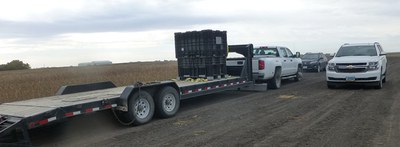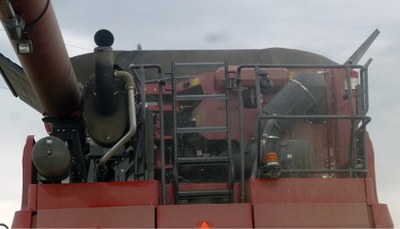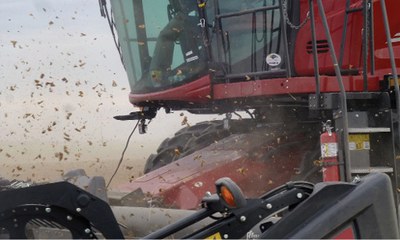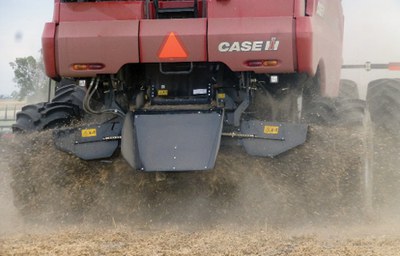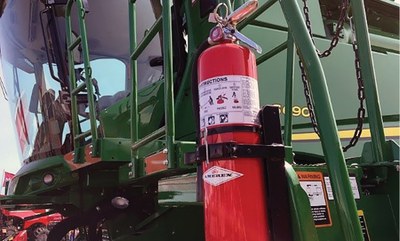Crop Harvest Fire Prevention Checklist (AE1991, Oct. 2020)
Availability: Web only
Fire Prevention
- Park trucks, pickups and cars in a place with minimal vegetation because hot exhaust emitted from equipment can start a fire. Avoid parking hot machinery on or near dry grass or other dry vegetation.
- Repair any leaks in the fuel system and any damaged electrical wiring.
- Repair or replace damaged or worn out exhaust systems.
- Never refuel equipment with the engine running. Allow hot engines to cool 15 minutes before refueling.
- Invert and shake extinguishers regularly to ensure machine vibrations don’t compact the powder inside.
Cleanliness
-
Chaff and debris will build up on hot vehicle components on combines and tractors while they are operated in fields. Therefore, you must clean engine areas at least daily. This can be done with an air compressor or leaf blower.
-
Harvesting sunflowers is particularly dangerous because stems are reduced to a very lightweight dust that can build up on the combine. Temperatures on the combine exhaust system components are high enough to ignite the sunflower dust.
-
Inspect the engine compartment where chaff may have accumulated around bearings, belts and other moving parts. Dust and trash become more combustible as they get drier and smaller.
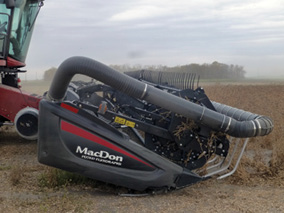
- NDSU
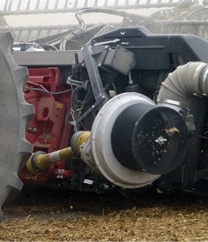
- NDSU
Fire Control
- In the event of a fire, turn off the machine and exit the cab immediately. Call 911 before trying to extinguish it yourself.
- Always carry two fire extinguishers on the combine, one in the cab and one that you can access from the ground. Also, carry a fire extinguisher in your grain hauling equipment.
- Make sure fire extinguishers are mounted on tractors and combines. Check extinguishers for these requirements:
- Inspect your fire extinguishers per manufacturer recommendations and fill out the card on the device.
- The pressure is at the recommended level. On extinguishers equipped with a gauge, the needle should be in the green zone.
- The nozzle or other parts are not hindered in any way.
- The pin and tamper seal are intact.
- The extinguishers have no dents, leaks, rust, chemical deposits or signs of wear.
- Replace the extinguisher even if it is only partially discharged.
- When using a fire extinguisher, remember this acronym: PASS
Pull the pin
Aim at the base
Squeeze
Sweep

For more information on this and other topics, see www.ag.ndsu.edu
The NDSU Extension does not endorse commercial products or companies even though reference may be made to tradenames, trademarks or service names. NDSU encourages you to use and share this content, but please do so under the conditions of our Creative Commons license. You may copy, distribute, transmit and adapt this work as long as you give full attribution, don’t use the work for commercial purposes and share your resulting work similarly. For more information, visit www.ag.ndsu.edu/agcomm/creative-commons.
County commissions, North Dakota State University and U.S. Department of Agriculture cooperating. NDSU does not discriminate in its programs and activities on the basis of age, color, gender expression/identity, genetic information, marital status, national origin, participation in lawful off-campus activity, physical or mental disability, pregnancy, public assistance status, race, religion, sex, sexual orientation, spousal relationship to current employee, or veteran status, as applicable. Direct inquiries to Vice Provost for Title IX/ADA Coordinator, Old Main 201, NDSU Main Campus, 701-231-7708, ndsu.eoaa@ndsu.edu. This publication will be made available in alternative formats for people with disabilities upon request, 701-231-7881.


